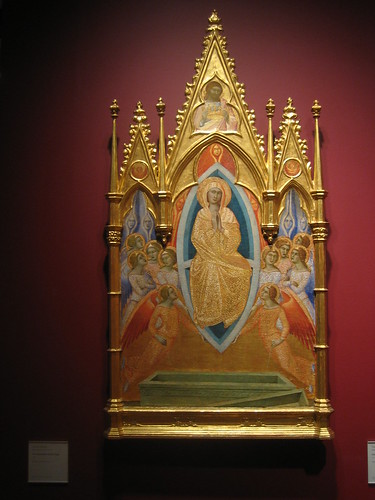I'm reading the introduction chapters of "The Renaissance Artist at Work" by Bruce Cole and was very intrigued by the discussion on the roles and functions of the artist guilds. I'm going to quote some sentences in the book to demonstrate the argument:
Before an apprentice could even begin to think about style, he had to learn how to make art. From the very first, Renaissance apprentices were introduced to the materials at the art store; in the Renaissance, most of the things used in the shop were made by the artist and his helpers. This early -- and lasting -- knowledge of the material, physical aspect of his craft endowed the artist with an almost instinctive feeling for the most basic properties of a picture, a sculpture, or an illustrated book. His understanding of materials and his skill in using them were extraordinary.
Any careful, first-hand examination of Renaissance art reveals that craft is of remarkable importance: paintings and sculpture from the period are among the most beautifully made objects in the entire history of Western art.

The Assumption of the Virgin, 1362, Luca di Tommè
The Renaissance concept that all works of art were functional and skillfully made objects renders the apprenticeship system more understandable.
Today, art is a manifestation of the artist's creative spirit. Certainly the sale of art is an important element, but thousands of artists who have little hope of ever selling their work still continue to paint and carve with great energy. Art is their calling and catharsis; financial rewards, most of them believe, are important but consideration of a lower order.
The apprenticeship system, with its long period of study, early acquaintance with varied materials, copying, and collaborative work, somehow allowed boys who were probably quite ordinary in every respect to be turned into men possessing a high degree of artistic skill. Art -- so the Renaissance believed -- could be taught by a series of progressive steps from grinding colors, to making copies, to work on the master's design, to inventing one's own paintings or sculptures.
All this may appear incredible to those who feel that the role of the art school is to encourage and train the already gifted. We do not believe that education alone can create a good artist: some kind of talent, of inspiration (divine or otherwise) marks a person for further artistic study.
Yet the vast majority of drawings, paintings, and sculptures produced in the Renaissance give clear evidence of the acquired skill of their authors.
It appears that it was indeed possible to train boys, who may or may not have had much talent, to a remarkable proficiency. Of course, the question remains: Could the Renaissance system of artistic education not only train most artists to be highly competent but also teach some of them to be great? Our immediate answer is no.
In the early sixteenth century, new attitudes began to form in some of the more intellectual artistic circles: Vasari, for example, looking into the history of Florentine art, calls Giotto divinely inspired. The idea that the artist was a special creator standing apart from society, above the guild-workshop system, was being born.
Nowadays, the value of art seems more to lie in its originality, its ideas rather than its execution. No doubt, this line of thinking, for better or worse, helped to usher in the mixed genres of art and the most talked about pieces of our time are often installations or works with performance built-in.
Furthermore, this book made me think about current very democratic art scene. Everyone who can draw a line, piece together a collage, or smear some paints on canvas can style himself or herself as an artist. Art making is not some lofty ideas one needs a license to practice. Art schools inspire students more on new ideas than tradition. This seems to agree with the believe of the Renaissance time, that every boy, and girl, can be trained to competent proficiency. But that argument is a false one. During the Renaissance time, as argued in the book, apprentices were trained rigorously and in our time, such discipline has been seriously compromised if not disregarded completely.
Then, we come to a crucial question: How much further can an artist push, if being new is the supreme goal? All ideas have been built on the previously exploited. Trying to cling to the current trend of new fad or technology would only make the values of such art creations temporal rather than timeless.
What a confusing time we live in.
Related articles:
--> More on Craftsmanship and Inspiration
--> Great Leap Forward to Make Oil Paintings in China





Betsy Lerner is an agent and former editor whose acerbic and incisive and often hilarious blog I follow pretty closely. Next up in my Google Reader after your post was one she wrote called Things are Happening Every Day.
ReplyDeleteIn this post, Lerner is responding to a frequent question, along the lines of 'I have an interesting story to tell, what should I do?' She writes: This is probably the most frequently asked question I get and yet somehow it always makes me apoplectic. Your story is not interesting, or not inherently interesting. Great writing and great storytelling is the only thing that is interesting.
Hmmmm... a strong argument for craft, from an experienced hand.